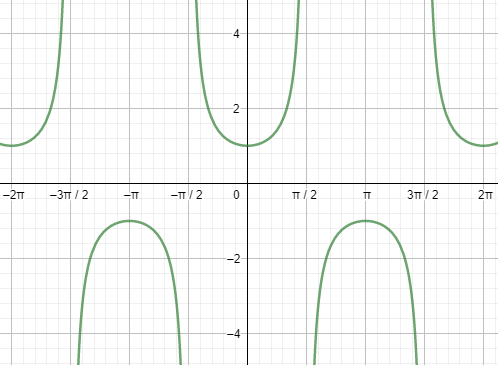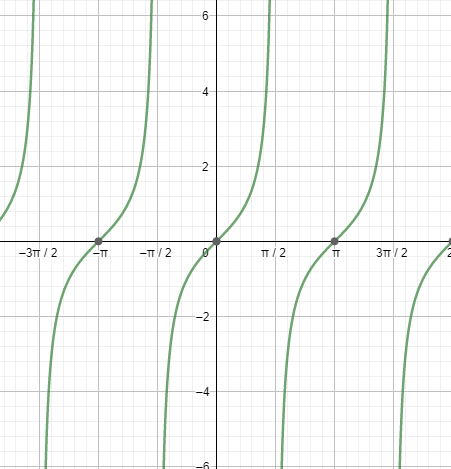Answer
414.6k+ views
Hint: Try to simplify the equation given in the question to reach a quadratic equation in terms of $\tan \theta $ . Solve the quadratic equation using the quadratic formula to reach the required result.
Complete step-by-step solution -
Before moving to the solution, let us discuss the periodicity of the secant and tangent function, which we would be using in the solution. All the trigonometric ratios, including secant and tangent, are periodic functions. We can better understand this using the graph of secant and tangent.
First, let us start with the graph of secx.

Next, let us see the graph of tanx.

Looking at both the graphs, we can say that the graphs are repeating after a fixed period i.e. $2{{\pi }^{c}}$ . So, we can say that the fundamental period of the secant function and the tangent function is $2{{\pi }^{c}}=360{}^\circ $
We will now simplify the equation given in the question.
$1+{{\sin }^{2}}\theta =3\sin \theta \cos \theta $
Now we will divide both the sides of the equation by ${{\cos }^{2}}\theta $ . Therefore, our equation becomes:
$\dfrac{1}{{{\cos }^{2}}\theta }+\dfrac{{{\sin }^{2}}\theta }{{{\cos }^{2}}\theta }=\dfrac{3\sin \theta \cos \theta }{{{\cos }^{2}}\theta }$
As we know that $\dfrac{1}{\cos \theta }=\sec \theta $ and $\dfrac{\sin \theta }{\cos \theta }=\tan \theta $ , we can say that:
${{\sec }^{2}}\theta +{{\tan }^{2}}\theta =3\tan \theta $
Now, if we use the formula ${{\sec }^{2}}\theta =1+{{\tan }^{2}}\theta $ , we get
$1+{{\tan }^{2}}\theta +{{\tan }^{2}}\theta =3\tan \theta $
$\Rightarrow 2{{\tan }^{2}}\theta -3\tan \theta +1=0$
Now as the above equation is a quadratic equation. So, we will use the quadratic formula to find the roots of the equation.
$\therefore \tan \theta =\dfrac{-b\pm \sqrt{{{b}^{2}}-4ac}}{2a}=\dfrac{-\left( -3 \right)\pm \sqrt{{{\left( -3 \right)}^{2}}-4\times 2\times 1}}{4}=\dfrac{3\pm 1}{4}$
Therefore, the possible values of $\tan \theta $ are 1 and $\dfrac{1}{2}$ .
Note: While simplifying trigonometric equations, it is always preferred to convert the equation to a form containing the least number of different trigonometric ratios. Also, give a thought to the trigonometric ratios involved in the expression, which is asked in the question, as that might give you a hint to solve the problem.
Complete step-by-step solution -
Before moving to the solution, let us discuss the periodicity of the secant and tangent function, which we would be using in the solution. All the trigonometric ratios, including secant and tangent, are periodic functions. We can better understand this using the graph of secant and tangent.
First, let us start with the graph of secx.

Next, let us see the graph of tanx.

Looking at both the graphs, we can say that the graphs are repeating after a fixed period i.e. $2{{\pi }^{c}}$ . So, we can say that the fundamental period of the secant function and the tangent function is $2{{\pi }^{c}}=360{}^\circ $
We will now simplify the equation given in the question.
$1+{{\sin }^{2}}\theta =3\sin \theta \cos \theta $
Now we will divide both the sides of the equation by ${{\cos }^{2}}\theta $ . Therefore, our equation becomes:
$\dfrac{1}{{{\cos }^{2}}\theta }+\dfrac{{{\sin }^{2}}\theta }{{{\cos }^{2}}\theta }=\dfrac{3\sin \theta \cos \theta }{{{\cos }^{2}}\theta }$
As we know that $\dfrac{1}{\cos \theta }=\sec \theta $ and $\dfrac{\sin \theta }{\cos \theta }=\tan \theta $ , we can say that:
${{\sec }^{2}}\theta +{{\tan }^{2}}\theta =3\tan \theta $
Now, if we use the formula ${{\sec }^{2}}\theta =1+{{\tan }^{2}}\theta $ , we get
$1+{{\tan }^{2}}\theta +{{\tan }^{2}}\theta =3\tan \theta $
$\Rightarrow 2{{\tan }^{2}}\theta -3\tan \theta +1=0$
Now as the above equation is a quadratic equation. So, we will use the quadratic formula to find the roots of the equation.
$\therefore \tan \theta =\dfrac{-b\pm \sqrt{{{b}^{2}}-4ac}}{2a}=\dfrac{-\left( -3 \right)\pm \sqrt{{{\left( -3 \right)}^{2}}-4\times 2\times 1}}{4}=\dfrac{3\pm 1}{4}$
Therefore, the possible values of $\tan \theta $ are 1 and $\dfrac{1}{2}$ .
Note: While simplifying trigonometric equations, it is always preferred to convert the equation to a form containing the least number of different trigonometric ratios. Also, give a thought to the trigonometric ratios involved in the expression, which is asked in the question, as that might give you a hint to solve the problem.
Recently Updated Pages
Assertion The resistivity of a semiconductor increases class 13 physics CBSE

The Equation xxx + 2 is Satisfied when x is Equal to Class 10 Maths

How do you arrange NH4 + BF3 H2O C2H2 in increasing class 11 chemistry CBSE

Is H mCT and q mCT the same thing If so which is more class 11 chemistry CBSE

What are the possible quantum number for the last outermost class 11 chemistry CBSE

Is C2 paramagnetic or diamagnetic class 11 chemistry CBSE

Trending doubts
Difference Between Plant Cell and Animal Cell

Difference between Prokaryotic cell and Eukaryotic class 11 biology CBSE

Fill the blanks with the suitable prepositions 1 The class 9 english CBSE

Change the following sentences into negative and interrogative class 10 english CBSE

Summary of the poem Where the Mind is Without Fear class 8 english CBSE

Give 10 examples for herbs , shrubs , climbers , creepers

Write an application to the principal requesting five class 10 english CBSE

What organs are located on the left side of your body class 11 biology CBSE

What is the z value for a 90 95 and 99 percent confidence class 11 maths CBSE



